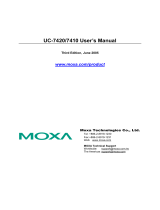
Table of Contents
1. Introduction ...................................................................................................................................... 1-1
Overview ........................................................................................................................................... 1-2
Software Specifications........................................................................................................................ 1-2
Software Components ......................................................................................................................... 1-2
2. Software Configuration ..................................................................................................................... 2-1
Accessing the DA-820 ......................................................................................................................... 2-2
Using a Monitor ........................................................................................................................... 2-2
Using an SSH Client ..................................................................................................................... 2-2
Logging in for the First Time ................................................................................................................ 2-4
Configuring sudo Access ...................................................................................................................... 2-5
Adding a User to the sudo Group ................................................................................................... 2-5
Using the sudo Command ............................................................................................................. 2-5
Configuring the System and Hardware Clock .......................................................................................... 2-6
Setting the Time Manually ............................................................................................................ 2-6
Synchronizing with a Network Time Server ..................................................................................... 2-6
Using a Script to Update the Time Automatically ............................................................................. 2-7
Enabling and Disabling Daemons .......................................................................................................... 2-8
Setting a Daemon to Run at Startup .............................................................................................. 2-9
Configuring Runlevels Using insserv .................................................................................................... 2-10
Scheduling Tasks Using cron .............................................................................................................. 2-11
Mounting a USB Storage Device.......................................................................................................... 2-12
Checking the Linux Version ................................................................................................................ 2-12
Installing and Removing Packages Using APT ....................................................................................... 2-13
Installing a Package ................................................................................................................... 2-13
Removing a Package .................................................................................................................. 2-14
Setting up a Desktop Environment ...................................................................................................... 2-14
3. Managing Communications ............................................................................................................... 3-1
Renaming a Network Interface ............................................................................................................. 3-2
Configuring Network Settings ............................................................................................................... 3-2
Editing an Interface Configuration File ............................................................................................ 3-2
Adjusting IP Addresses Using ifconfig ............................................................................................. 3-3
Configuring Telnet and TFTP Servers ..................................................................................................... 3-3
Enabling the Telnet or TFTP Server ................................................................................................ 3-4
Disabling the Telnet or TFTP Server ............................................................................................... 3-4
Setting up DNS Client.......................................................................................................................... 3-4
/etc/hostname ............................................................................................................................ 3-4
/etc/resolv.conf ........................................................................................................................... 3-4
/etc/nsswitch.conf ....................................................................................................................... 3-5
Configuring Ethernet Bonding ............................................................................................................... 3-5
Configuring the Apache Web Server ...................................................................................................... 3-7
Default Homepage ....................................................................................................................... 3-7
Disabling the CGI Function ........................................................................................................... 3-7
Saving Web Pages to a USB Storage Device .................................................................................... 3-8
Configuring IPTABLES ......................................................................................................................... 3-9
IPTABLES Hierarchy ................................................................................................................... 3-10
IPTABLES Modules ..................................................................................................................... 3-11
Viewing Rules and Deleting Chains .............................................................................................. 3-12
Defining Chain Policies ............................................................................................................... 3-12
Adding or Deleting Rules ............................................................................................................ 3-13
NAT (Network Address Translation) ..................................................................................................... 3-14
NAT Example ............................................................................................................................ 3-14
Enabling NAT during System Startup............................................................................................ 3-14
PPP (Point to Point Protocol) ............................................................................................................... 3-15
Connecting to a PPP Server Using a Dial-up Connection .................................................................. 3-15
Connecting to a PPP Server over a Hard-wired Link ........................................................................ 3-16
Checking the Connection ............................................................................................................ 3-16
Configuring the Server for Incoming PPP Connections .................................................................... 3-18
Configuring PPPoE............................................................................................................................. 3-19
NFS (Network File System) Client ....................................................................................................... 3-21
OpenVPN ......................................................................................................................................... 3-21
Ethernet Bridging for Private Networks on Different Subnets ........................................................... 3-22
Ethernet Bridging for Private Networks on the Same Subnet ........................................................... 3-25
Configuring IP Routing ..................................................................... 3-Error! Bookmark not defined.
4. Programming Guide .......................................................................................................................... 4-1
Getting Product Serial Number ............................................................................................................. 4-2
RTC (Real Time Clock) ......................................................................................................................... 4-2
UART ................................................................................................................................................ 4-2
























